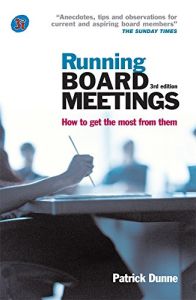Join getAbstract to access the summary!

Join getAbstract to access the summary!
Patrick Dunne
Running Board Meetings
How to Get the Most from Them
Kogan Page, 2005
What's inside?
When you have to come to order, check this guide to running board meetings, from the agenda to the annoying personalities.
Recommendation
Author Patrick Dunne shows a rare ability to imbue a dry subject – running board meetings – with warmth and humor. The author clearly knows his topic, and walks you through the process of planning and running board meetings step by step. He covers the what, where, when, why and how, all in engaging prose, and then moves on to more subtle concerns, such as resolving conflicts and dealing with your board members' various personalities. His amusing anecdotes and charming real-life stories flesh out an otherwise pedestrian topic, though someone from the twenty-first century needs to slip him a note about using gender-neutral language. The volunteer nonprofit organization board chair might find good guidance here that would be a bit basic for an executive who has already exercised sufficient skill, stealth and strength to end up in charge of a corporate board. And yet even such an executive may appreciate this little primer. Given that, getAbstract recommends this entertaining text to all those who get to sit in the big chair at the head of the table, be it mahogany or not.
Summary
About the Author
Patrick Dunne is group communications director at a European venture capital firm and a visiting professor at the Cranfield School of Management. He is the author of Director's Dilemma and he frequently speaks on boardroom issues.


















Comment on this summary